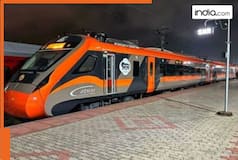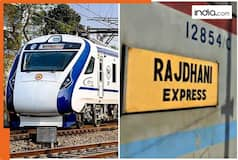Things you must know about India’s first hydrogen-powered train; Check route map, other details
According to Indian Railways, Haryana’s Jind-Sonipat route was picked for trial run of India’s hydrogen-powered train because the route has well-developed infrastructure and sees a moderate amount of train traffic.
In a major step towards boosting environment-friendly sustainable transportation in India, the Indian Railways is geared up to launch its first hydrogen-powered train on the Jind-Sonipat route in Haryana in December this year. The eco-friendly carriage, the first hydrogen-powered train in India, will ply on Haryana’s 90-kilometer long Jind-Sonipat route .
Check out these key details about India’s first hydrogen-fueled train:
Quiet, ec0-friendly and more energy-efficient
As the title suggests, the train is powered by hydrogen fuel cells which are used to generate electricity which powers the train. The hydrogen-based fuel emits only water vapor as a byproduct, making it a completely zero-emission solution as Indian Railways eyes to meet its net-zero carbon emissions goal by 2030.
Apart from being environment-friendly, the hydrogen-powered train is much more energy-efficient and a lot more quieter than its conventional diesel or coal-powered counterparts, which makes it a far better choice for a greener future, in addition to the advantage of reduced noise pollution.
Cost-effective
Built at an estimated cost of around Rs 80 crore, hydrogen trains are cost-effective in the long run as they run on hydrogen fuel, which is touted as the fuel of the future, and will cut down the cost of operating these trains once production starts on a mass scale, and fuel cost become more affordable.
Additionally, unlike conventional trains which run on fossil fuels, which is bound to run out in the near future, hydrogen is a man-made fuel and can be mass produced.
No electrification required
Unlike other non-diesel trains, hydrogen-powered trains do not require electrified tracks to run, thus the added cost of building expensive electrified tracks is nullified. This makes the hydrogen trains a much better alternative to diesel-powered trains, as the eco-friendly carriages can ply on non-electrified routes in rural and under-developed areas of the country where electrification is not feasible.
Pocket-friendly for travelers
Hydrogen-powered trains can become a far more affordable option for travelers in the near future as the besides the initial manufacture and infrastructure cost, these trains require minimal maintenance and run on hydrogen fuel, which is bound to become cheaper in coming years.
According to the railways, each hydrogen-powered train costs around Rs 80 crore, and the infrastructure required to run these modern trains cost an additional Rs 70 crore.
The Indian Railways is pushing collaborative efforts with domestic and international partners to develop hydrogen production and storage facilities, aimed at the mass scale production of hydrogen fuel in the future.
Officials said the railways aims to expand the hydrogen train network in coming years, with 35 such trains planned to launched by the end of 2025.
Why railways chose Jind-Sonipat route?
According to Indian Railways, Haryana’s Jind-Sonipat was picked for trial run of India’s hydrogen-powered train because the route has well-developed infrastructure and sees a moderate amount of train traffic. These factors will enable the railways to evaluate the train’s real-world performance, safety, and operational capabilities, officials said.
Also Read:





Comments are closed.